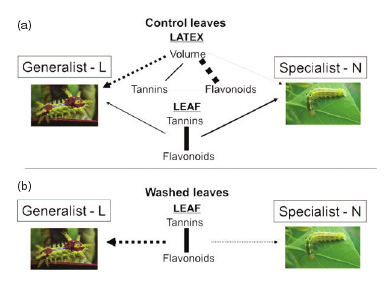
Biogeographical Variation in Latex Defences Enlightens Plant Defence and Invasive Mechanism
May 04, 2014 Email"> PrintText Size

In the introduced ranges, many exotic plants experience reduced herbivore regulation, especially from the specialist herbivores, which could lead to differences in defences among native and invasive populations. If the defence is costly, exotic plants would evolve to invest more resources in growth or reproduction, otherwise, more effective against generalists. Compared with constitutive defences, inducible defences have lower costs, which are always expressed in a plant. Therefore, invasive plants could change inducible defences in their invasive range due to differences in the frequency and types of herbivore attack in a way that is different than the pattern for constitutive defences.
Latex functions as a physical and chemical defence against herbivores that may vary in their responses to latex quantity and chemical composition.
A research team led by Prof. DING Jianqing from Wuhan Botanical Garden compared latex produced by seedlings from native and invasive populations of tallow tree (Triadica sebifera) when damaged by a native specialist or generalist caterpillar. Results showed that the specialist induced more latex production than the generalist did, especially for plants from invasive populations. Tannins increased and flavonoids decreased when plants were damaged by the generalist caterpillar but neither changed when plants were damaged by the specialist caterpillar.
This research is the first to examine the amount of latex exudation and chemical composition when damaged by different herbivores and compare the induction of introduced and native plant populations. It suggests divergent selection on the physical and chemical properties of latex in the introduced range. The quantity of latex produced was more sensitive to herbivore identity in the introduced range but the specificity of the latex chemical response was retained. These finding may help to better understand the ecology and evolution of plant defence and invasive mechanism.
Study was supported by the National Program on Key Basic Research Project, a Foreign Visiting Professorship of the Chinese Academy of Sciences, US-NSF and Association of youth innovation promotion of the Chinese Academy of Sciences. Results were published in Ecological Entomology entitled “Invasive plant population and herbivore identity affect latex induction”.

Graphical models showing the correlation among latex properties, correlation among foliar chemicals and the correlations of each with biomass of specialist and generalist caterpillars. (a) control leaves and (b) washed leaves. (Image by WBG)
In the introduced ranges, many exotic plants experience reduced herbivore regulation, especially from the specialist herbivores, which could lead to differences in defences among native and invasive populations. If the defence is costly, exotic plants would evolve to invest more resources in growth or reproduction, otherwise, more effective against generalists. Compared with constitutive defences, inducible defences have lower costs, which are always expressed in a plant. Therefore, invasive plants could change inducible defences in their invasive range due to differences in the frequency and types of herbivore attack in a way that is different than the pattern for constitutive defences.
Latex functions as a physical and chemical defence against herbivores that may vary in their responses to latex quantity and chemical composition.
A research team led by Prof. DING Jianqing from Wuhan Botanical Garden compared latex produced by seedlings from native and invasive populations of tallow tree (Triadica sebifera) when damaged by a native specialist or generalist caterpillar. Results showed that the specialist induced more latex production than the generalist did, especially for plants from invasive populations. Tannins increased and flavonoids decreased when plants were damaged by the generalist caterpillar but neither changed when plants were damaged by the specialist caterpillar.
This research is the first to examine the amount of latex exudation and chemical composition when damaged by different herbivores and compare the induction of introduced and native plant populations. It suggests divergent selection on the physical and chemical properties of latex in the introduced range. The quantity of latex produced was more sensitive to herbivore identity in the introduced range but the specificity of the latex chemical response was retained. These finding may help to better understand the ecology and evolution of plant defence and invasive mechanism.
Study was supported by the National Program on Key Basic Research Project, a Foreign Visiting Professorship of the Chinese Academy of Sciences, US-NSF and Association of youth innovation promotion of the Chinese Academy of Sciences. Results were published in Ecological Entomology entitled “Invasive plant population and herbivore identity affect latex induction”.

Graphical models showing the correlation among latex properties, correlation among foliar chemicals and the correlations of each with biomass of specialist and generalist caterpillars. (a) control leaves and (b) washed leaves. (Image by WBG)
CAS Institutes
There are 124 Institutions directly under the CAS by the end of 2012, with 104 research institutes, five universities & supporting organizations, 12 management organizations that consist of the headquarters and branches, and three other units. Moreover, there are 25 legal entities affiliated and 22 CAS invested holding enterprisesThere are 124 I...>> more
Contact Us

Chinese Academy of Sciences
Add: 52 Sanlihe Rd., Xicheng District, Beijing, China
Postcode: 100864
Tel: 86-10-68597592 (day) 86-10-68597289 (night)
Fax: 86-10-68511095 (day) 86-10-68512458 (night)
E-mail: cas_en@cas.cn

